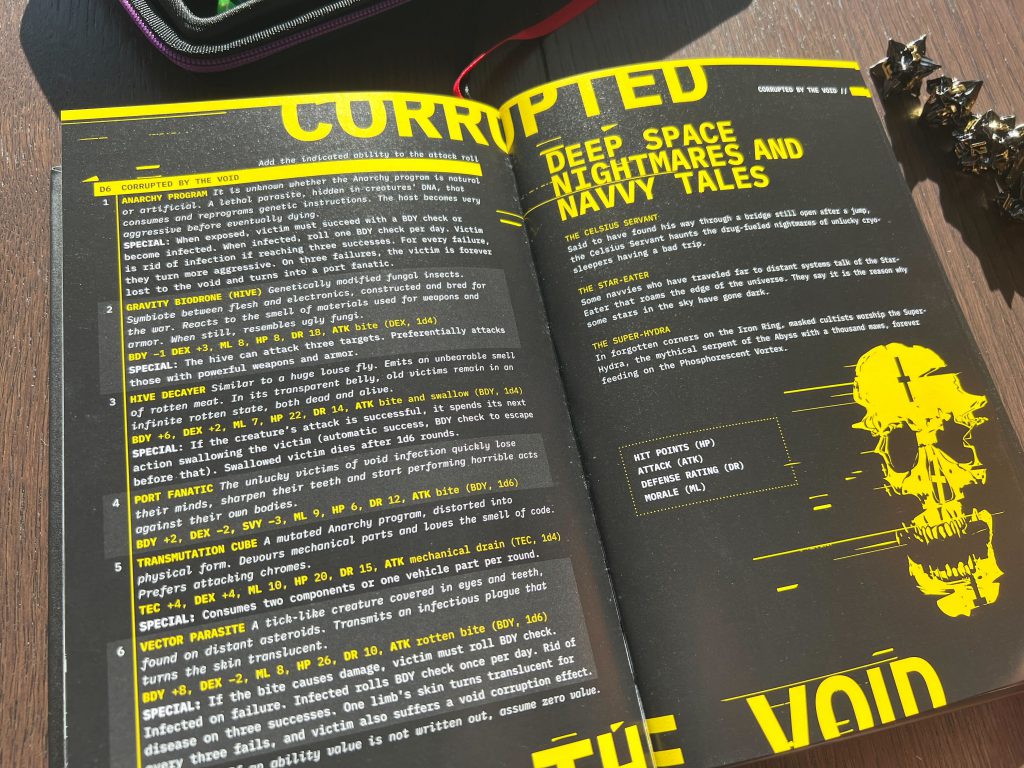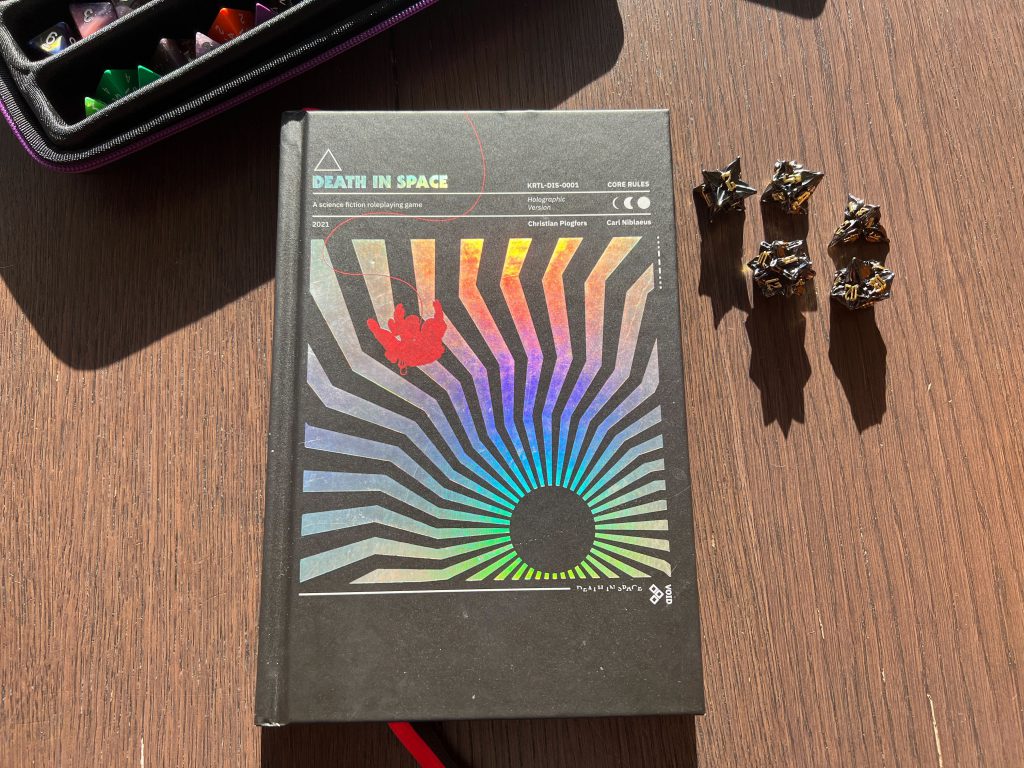Death in Space Explained
Death in Space is a grimy, post-societal science fiction roleplaying game set in a devastated solar system where all that’s left is a hodge-podge of blue-collar workers, scraping by in space communes.
The classic story arc of an RPG takes players from resolving local issues to, in some capacity or another, saving the world. Systems like modern D&D or Scion, plop you straight into the middle of a troubled-time, but rapidly equip you with the capacity to play with the toys (or powers) of the gods — and, in time, a lot of DMs of those settings will find themselves enabling players to battle against those ancient demons and fallen gods. This is probably why I’ve fallen in love with some of the settings that Free League has recently published. Systems and settings like Mörk Borg and Death in Space where hope is gone and there’s no way for the players to exist on the same level as any gods or ancient masters. They’re more about survival against the odds than exploring a romanticised world, they also happen to ooze nihilism.
In the future humanity finds a new resource in space, its power is immense and it can easily change the grimy, greasy spacefaring species’ fate into something maybe a little bit closer to the idealistic, bleached white, sterile science-fiction future we sometimes spot in other media. However, humanity here is hyper-capitalist — think Alien, Outlander, Blade Runner, Ad Astra — and so what happens is a space gold rush, and then, sabotage and then, all-out war. Death in Space starts ten years after the war is over. Players aren’t the humans who risk life and limb facing the Void, risking insanity as they jaunt between the stars, but the blue-collar survivors who exist on and around the interlinked chain of space-ships that form a ring around the devastated, ruined planet that triggered the whole gold rush. Technology pivoted so hard during the war that no new technology is being built — factions fight with iron pipes and shotguns over the old scraps required to keep the more modern technology functional.
Where does this put the players? Much like in Mörk Borg they’re trapped in a society that’s collapsing. Unlike Mörk Borg‘s gothic horror though, Death in Space is positively post-apocalyptic; It’s gritty, greasy and anachronistic because of society’s own failings. Not only that, but it’s also chaotic, with logic and existence itself being warped and twisted — touch the wrong thing and you might, simply, be turned into an inert chrome orb, or sucked into a computer program.

Is Death in Space good?
In a word, yes. Death in Space is a great setting which toes a line that few other settings get near approaching. In all my years playing I’ve not come across the kind of gritty, deep-space setting that the rulebook stirs up. It’s also incredibly easy to pick up and play, due in large part to the fact that the system strips out the ‘Skills’ system that we see prevalent in so many other systems. Here you’re simply using four different abilities: Body, Technology, Savvy and Dexterity which cover all of the bases.
It’s a setting that’s teeming with character, and much like other recent titles from members of the Stockholm Kartell, it’s right there in everything from character creation through to the tables of items, pocket loot and void corruptions. The latter are like technology curses: “When you try to sleep, you see through someone else’s eyes”, for example.

Character creation, beyond the four attributes, features a really great Origin system which guts out the ‘classes’ and ‘races’ of other systems and instead gives you a description of how you came to be, complete with features, direction and some really invaluable skills. Skills such as the ability to have natural conversations with machines, or to have an old useful contact at every station. After that, you get to quirks, traits, occupation and even a table discussing the character’s drive.
The character creation section is dwarfed by the instructions on space travel and hub creation though. The player’s hub is their way of getting around, it’s a clunky old piece of cobbled-together junk, barely operational, that can be built up, repaired and fully destroyed. There are extensive tables talking about the upgrades, as well as a well-written section about how damage works. Your hub can be static or can float free, depending entirely on the type of campaign the GM is running. This ties into the repair and condition systems; Both are essential in a setting where even the newest things are on their fifth or sixth owner.
How easy is Death in Space to play?
I mentioned earlier that the core of the game is stripped down to those four abilities: Body, Technology, Savvy and Dexterity. I didn’t mention that they, themselves are basically the ability modifiers you find in other systems. Your character could be walking around with an ability set of -2, -1, 1, -3 and be fully functional — well, as functional as you can be in a chaotic deep-space scenario following a socioeconomic collapse.
In keeping it simple, most difficulty checks are recommended to simply be modifier+D20 roll vs D12, with familiar rules for advantage and disadvantage (roll two, keep one) there to round things off. This keeping-it-simple attitude runs throughout, even when it reaches territories that systems like D20 Modern tripped over like vehicular combat.

Death in Space’s real beauty comes in the tables and the extra bits that it prepares you for. It doesn’t provide you with a list of cities, or valuable commodities (if such a thing could still exist), but it does have tables and rules for hub & character creation, quirks, traits and backgrounds as well as off-world and space travel rules. There are tables for the horrible ways you should die and could die, as well as a set of tables to quickly roll a trap type and its trigger. On that note, death is quick, which makes for strong, tense, short scenarios. Handy as longer campaigns might be tricky with the lack of defined locations.
The Void Point System
Void Points are an interesting mechanic that shows up surprisingly often in Death in Space. Any time you fail an ability or attack roll a player gains one, and it can then be used to give an advantage roll on an ability or attack roll, but at a risk of triggering very bad stuff (Void Corruption — deep space curses) if you roll poorly. In addition to this, you can also crack out Void Mutations, which are weird, dangerous abilities that can flip an encounter on its head. Whether it works or doesn’t, it can completely flip a game on its head and require characters to rethink their entire approach to a scenario or campaign.

Death in Space in review
Death in Space feels like a scrappy, Wild West in space. There’s a chance of getting out of town, of going to other systems, but it’s at great risk. This isn’t a scenario which wants you to skip town, it wants you to knuckle down and make a name for yourself with what you have. This does give room for the GMs to expand; but this kind of game is best played when you have half a dozen major NPCs you deal with regularly, running rescue missions, diplomacy or bounty hunting… in space.
Death in Space is all about reputation and having friends with resources – much more than currency. The ring’s halls are filled with AI bodyguards, food carts and destitution, it’s a space slum that you can possibly make safe, but you can’t save it from its fate.

My favourite part is the extensive tables and tools section; there are tables for creatures, locations in The Ring, triggers for traps, space encounters and a mass of tables regarding spaceship generation and customisation. There’s also a great NPC generator and, finally, the back page serves as a fantastic little cheat sheet for most of the rolls in the game. Stepping away from the standard skills system does put a bit more pressure on the players and the game master, however, in a setting like this, and with extreme traits, and wider descriptions of attributes, it’s incredibly easy to just simply dive into and play as an outlandish character.
The version I received didn’t include the extra scenario or map that now seems to come with it, which seem like lovely little inclusions. And the only negative that I can see with the printing is that blue on black, which some of the headings are, can be incredibly hard to read for some. That said, the art-free version is available in black and white online, which gives a digital alternative to squinting at dark backgrounds trying to figure out some of the words.
Death in Space is available now. There’s a bunch of cool accompanying materials available on the official site, as well as on the website of its publisher, Free League.
Comments are closed.